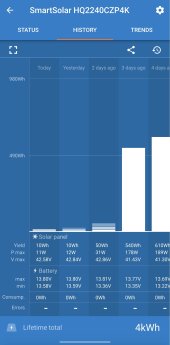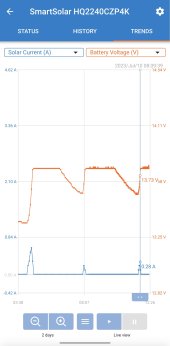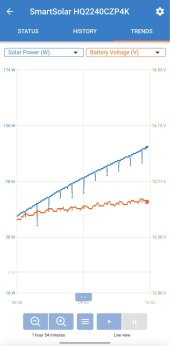Hey all,
Just set up a basic solar system on my van. Not my first but first time using lithium.
2x 100w in series, Victron 100/20 mppt and one of those 200ah Renogy batteries with bluetooth.
Absorption at 14.2 for 1 hour, float at 13.6
I haven't moved into the van yet so the electrical system has only had very little use but it's been connected and parked outside for a couple of weeks.
There's a weird thing going on where some nights but not others, as soon as the sun goes down, the battery voltage gradually decreases to about 13V or slightly below, without any loads whatsoever. Other nights it settles around 13.3-13.4 and stays there until sunrise which I believe is the expected behavior.
Any ideas what's going on? Is the battery likely faulty?
Also, on the Victron controller app's History page, I've seen the maximum battery voltage on some days reach up to 17V! If I check the Trends tab soon afterwards I can see the spike in the graph but if I don't look for a few hours the high battery voltage still shows on the History tab but seems to have been smoothed out of the graph in Trends.. Is this normal behavior?
And lastly, how much difference in voltage between cells is deemed acceptable? On the Renogy app, with the battery at 100%, cells 1 and 4 are at 3.5V, while 2 and 3 are at 3.3V.
Here are a few screenshots showing the behaviors described above
A few normal nights followed by one night where the battery seemingly self discharges (with a short period where it jumps back up to the expected voltage then starts decreasing again):
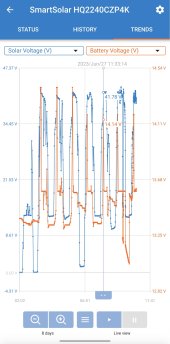
That same bad night followed by the same thing happening the following night:
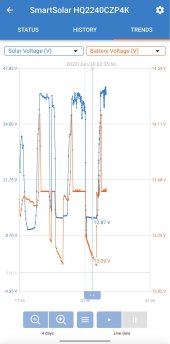
Battery voltage reaching 17.14V:
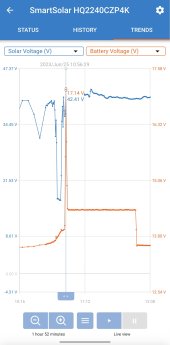
History page showing battery max voltages reaching high 15 to 16+ volts on multiple days:
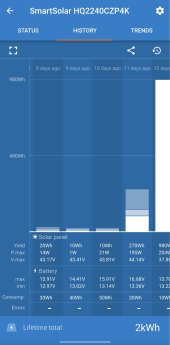
Any input is much appreciated!
Thanks
Just set up a basic solar system on my van. Not my first but first time using lithium.
2x 100w in series, Victron 100/20 mppt and one of those 200ah Renogy batteries with bluetooth.
Absorption at 14.2 for 1 hour, float at 13.6
I haven't moved into the van yet so the electrical system has only had very little use but it's been connected and parked outside for a couple of weeks.
There's a weird thing going on where some nights but not others, as soon as the sun goes down, the battery voltage gradually decreases to about 13V or slightly below, without any loads whatsoever. Other nights it settles around 13.3-13.4 and stays there until sunrise which I believe is the expected behavior.
Any ideas what's going on? Is the battery likely faulty?
Also, on the Victron controller app's History page, I've seen the maximum battery voltage on some days reach up to 17V! If I check the Trends tab soon afterwards I can see the spike in the graph but if I don't look for a few hours the high battery voltage still shows on the History tab but seems to have been smoothed out of the graph in Trends.. Is this normal behavior?
And lastly, how much difference in voltage between cells is deemed acceptable? On the Renogy app, with the battery at 100%, cells 1 and 4 are at 3.5V, while 2 and 3 are at 3.3V.
Here are a few screenshots showing the behaviors described above
A few normal nights followed by one night where the battery seemingly self discharges (with a short period where it jumps back up to the expected voltage then starts decreasing again):

That same bad night followed by the same thing happening the following night:

Battery voltage reaching 17.14V:

History page showing battery max voltages reaching high 15 to 16+ volts on multiple days:

Any input is much appreciated!
Thanks
Last edited:





